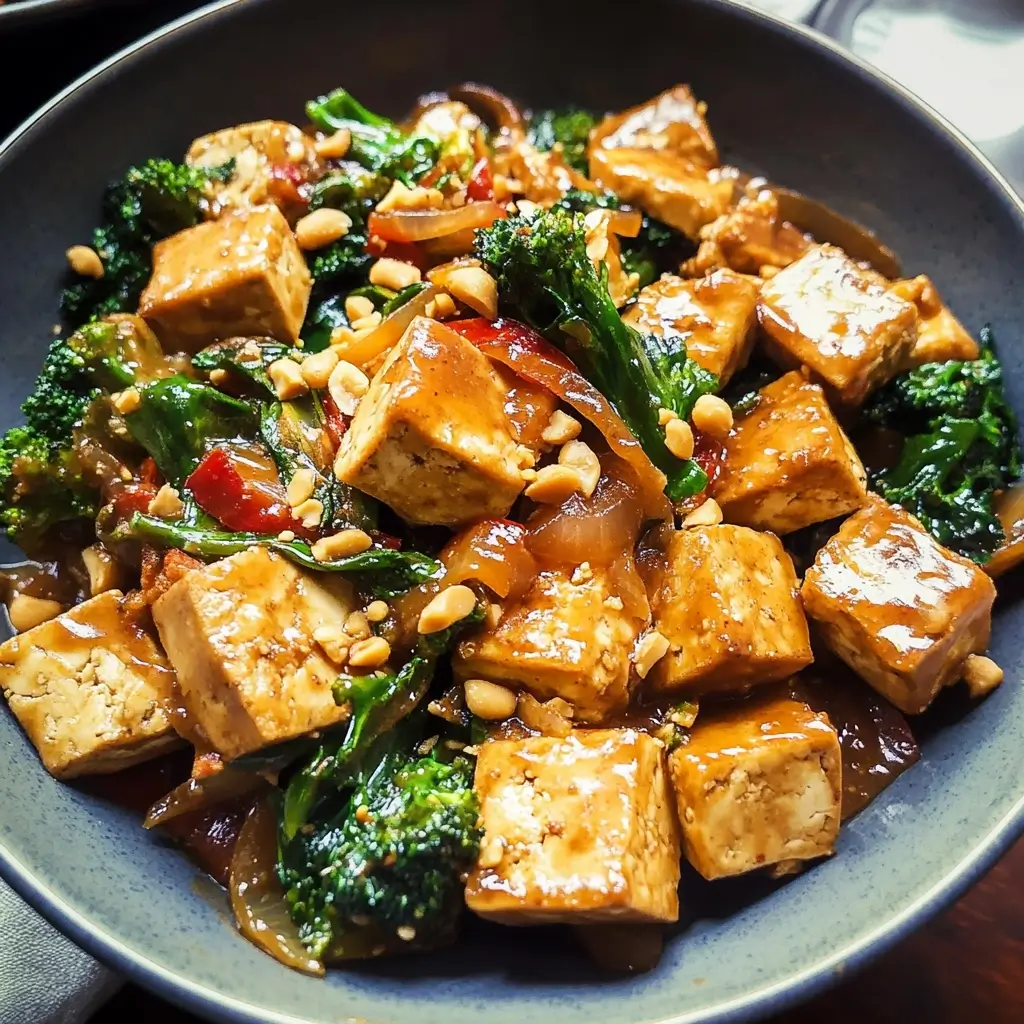After a long week, the last thing I want to do is spend hours in the kitchen. That’s when this Tofu Stir-Fry with Peanut Sauce becomes my absolute go-to. It’s vibrant, flavorful, and comes together quicker than ordering takeout. My family, even the self-proclaimed meat-lovers, devour it every time. The crispy tofu combined with the crunchy vegetables and that luscious, nutty peanut sauce is simply irresistible. It’s become a staple in our household for busy weeknights and even casual weekend gatherings. If you’re looking for a healthy, satisfying, and incredibly delicious plant-based meal, look no further. This recipe is a guaranteed crowd-pleaser and a fantastic way to incorporate more tofu into your diet. Trust me, once you try this, you’ll be adding it to your regular rotation too!
Ingredients
Creating a truly exceptional Tofu Stir-Fry with Peanut Sauce hinges on the quality and freshness of your ingredients. Let’s delve into each component, exploring not just what you need, but why, and even offering some helpful substitutions or enhancements to tailor this dish perfectly to your taste and pantry.
For the Tofu:
- 1 block (14-16 ounces) extra-firm or firm tofu: The foundation of our stir-fry, tofu provides a fantastic source of plant-based protein and a satisfying texture. Extra-firm tofu is generally preferred as it contains less water and will crisp up better during cooking, offering a delightful contrast to the soft vegetables and rich sauce. Firm tofu also works well, but you may need to press it for a bit longer to remove excess moisture. Avoid silken or soft tofu; these varieties are too delicate for stir-frying and will crumble easily.
- 2 tablespoons cornstarch or arrowroot powder: This is your secret weapon for achieving crispy tofu. Coating the tofu in cornstarch or arrowroot powder before cooking creates a beautiful golden-brown crust that locks in moisture and delivers a delightful textural contrast. Arrowroot powder is a great gluten-free alternative to cornstarch and offers a similar crispy result.
- 2 tablespoons soy sauce or tamari (for gluten-free): Soy sauce is essential for adding savory umami depth to the tofu and the overall stir-fry. It also helps to tenderize the tofu slightly and contributes to that desirable browned color when cooked. For those following a gluten-free diet, tamari is an excellent substitute. It offers a similar flavor profile to soy sauce but is made without wheat. Low-sodium options for both soy sauce and tamari are readily available and recommended for controlling sodium intake.
- 1 tablespoon sesame oil: Sesame oil brings a distinctive nutty aroma and flavor that is quintessential in Asian cuisine and perfectly complements the peanut sauce. Toasted sesame oil is preferred for its richer and more pronounced flavor, but regular sesame oil will also work. A little goes a long way with sesame oil, so a tablespoon is usually sufficient to infuse the tofu with its characteristic warmth.
For the Stir-Fry Vegetables:
- 1 tablespoon olive oil or avocado oil: These oils are excellent choices for stir-frying due to their high smoke points. Olive oil provides a subtle fruity note, while avocado oil is virtually flavorless, allowing the other ingredients to shine. Other suitable high-heat oils include canola oil, grapeseed oil, and peanut oil.
- 1 red bell pepper, sliced: Bell peppers add a vibrant color, a touch of sweetness, and a satisfying crunch to the stir-fry. Red bell peppers are slightly sweeter than green or yellow, but you can use any color combination you prefer. Sliced into strips, they cook quickly and evenly in the stir-fry.
- 1 green bell pepper, sliced: Adding a green bell pepper alongside the red enhances the visual appeal and introduces a slightly different flavor profile – green peppers have a more herbaceous and slightly less sweet taste compared to red.
- 1 cup broccoli florets: Broccoli provides a wonderful textural element and is packed with nutrients. Florets are easy to stir-fry and retain a pleasant crisp-tenderness. You can use fresh or frozen broccoli florets (ensure frozen broccoli is thawed and drained well before stir-frying).
- 1 cup snow peas or snap peas: Snow peas or snap peas contribute a delicate sweetness and a satisfying snap to the stir-fry. They cook very quickly, so add them towards the end of the stir-frying process to maintain their crispness.
- 1 medium carrot, julienned or thinly sliced: Carrots add sweetness, color, and a satisfying crunch. Julienne carrots (thin strips) or thin slices cook quickly and evenly in the stir-fry.
- 1/2 red onion, thinly sliced: Red onion offers a pungent and slightly sweet flavor that adds depth to the stir-fry. Thinly sliced red onion cooks quickly and becomes pleasantly tender during stir-frying. You can also use yellow or white onion if preferred.
- 2 cloves garlic, minced: Garlic is a fundamental aromatic ingredient that infuses the stir-fry with its pungent and savory flavor. Freshly minced garlic is always best for optimal flavor.
- 1 inch ginger, grated or minced: Fresh ginger adds a warm, spicy, and slightly citrusy note that is crucial for authentic stir-fry flavor. Grated or minced ginger disperses its flavor effectively throughout the dish.
For the Peanut Sauce:
- 1/2 cup creamy peanut butter: The star of the sauce, creamy peanut butter provides the signature nutty flavor and creamy texture. Choose a natural peanut butter with minimal added sugar and salt for a healthier option. Smooth peanut butter is essential for a silky sauce; crunchy peanut butter will result in a sauce with texture.
- 1/4 cup soy sauce or tamari (for gluten-free): Soy sauce (or tamari) in the sauce provides a savory and umami base that balances the sweetness of the peanut butter and other ingredients. Low-sodium options are recommended to control salt levels.
- 1/4 cup rice vinegar: Rice vinegar adds a crucial tanginess and acidity to the peanut sauce, cutting through the richness of the peanut butter and creating a balanced flavor profile. Unseasoned rice vinegar is preferred to avoid added sugar.
- 2 tablespoons honey or maple syrup (for vegan): A touch of sweetness is essential to balance the savory and tangy flavors in the peanut sauce. Honey or maple syrup are excellent natural sweeteners. Maple syrup is the perfect vegan alternative to honey. Adjust the amount to your sweetness preference.
- 2 tablespoons lime juice: Fresh lime juice adds a bright, citrusy zing that elevates the peanut sauce and complements the other flavors. Freshly squeezed lime juice is always preferable for its vibrant flavor.
- 1 tablespoon sesame oil: A touch of sesame oil in the sauce enhances the nutty aroma and flavor, tying it in beautifully with the stir-fried tofu and vegetables.
- 1 tablespoon grated fresh ginger: Ginger in the sauce reinforces the warm and spicy notes and adds another layer of complexity to the flavor profile.
- 1 clove garlic, minced: Garlic in the sauce complements the garlic used in the stir-fry and contributes to the overall savory depth.
- 1/2 teaspoon red pepper flakes (optional, for heat): For those who enjoy a bit of spice, red pepper flakes add a pleasant kick to the peanut sauce. Adjust the amount to your desired level of heat or omit entirely if you prefer a milder sauce.
- Water, as needed, to adjust consistency: Water is used to thin the peanut sauce to your desired consistency. Start with a tablespoon or two and add more gradually until the sauce is smooth and pourable.
Optional Garnishes:
- Chopped peanuts or sesame seeds: These add a delightful crunch and visual appeal to the finished dish. Toasted sesame seeds offer a richer flavor.
- Chopped fresh cilantro or green onions: Fresh herbs add a bright, fresh finish and a pop of color. Cilantro and green onions are both excellent choices.
- Lime wedges: Serving lime wedges alongside allows individuals to add an extra squeeze of fresh lime juice to their portion, further enhancing the flavors.
Instructions
Creating this delectable Tofu Stir-Fry with Peanut Sauce is a surprisingly straightforward process, even for novice cooks. Follow these detailed step-by-step instructions to ensure success, and you’ll be enjoying a restaurant-quality meal in no time.
Step 1: Prepare the Tofu
- Press the Tofu (Essential for Crispiness): This is a crucial step to remove excess water from the tofu, which will allow it to crisp up beautifully during cooking. There are several methods for pressing tofu:
- Tofu Press: If you frequently cook with tofu, investing in a tofu press is worthwhile. These devices apply consistent pressure and are very efficient. Follow the manufacturer’s instructions for your specific press.
- DIY Press (Plate and Weights Method): Wrap the tofu block in several layers of paper towels or a clean kitchen towel. Place it on a plate and then put another plate on top. Weigh it down with heavy objects like canned goods, books, or a heavy skillet. Press for at least 30 minutes, ideally for an hour. The longer you press, the drier and crispier the tofu will become. Change the paper towels/kitchen towel if they become saturated with water.
- Cube the Tofu: Once pressed, cut the tofu block into bite-sized cubes, approximately ½ to ¾ inch in size. Uniformly sized cubes will cook more evenly.
- Marinate the Tofu (Optional but Recommended): In a medium bowl, gently toss the tofu cubes with 2 tablespoons of soy sauce (or tamari) and 1 tablespoon of sesame oil. Marinating for even 15-20 minutes will infuse the tofu with flavor and enhance its overall taste. For a deeper flavor, you can marinate for up to an hour in the refrigerator.
- Coat the Tofu in Cornstarch/Arrowroot: In a separate bowl or a large zip-top bag, place the cubed and marinated tofu. Sprinkle 2 tablespoons of cornstarch or arrowroot powder over the tofu. Gently toss or shake the bag to ensure each tofu cube is evenly coated. This coating is what creates that desirable crispy exterior.
Step 2: Prepare the Peanut Sauce
- Combine Sauce Ingredients: In a medium bowl, whisk together the ½ cup creamy peanut butter, ¼ cup soy sauce (or tamari), ¼ cup rice vinegar, 2 tablespoons honey or maple syrup, 2 tablespoons lime juice, 1 tablespoon sesame oil, 1 tablespoon grated fresh ginger, and 1 minced clove of garlic. If using red pepper flakes for heat, add ½ teaspoon (or to taste) now.
- Adjust Consistency: The sauce should be smooth and pourable but not too thin. Start by adding water, one tablespoon at a time, whisking well after each addition, until you reach your desired consistency. You may need anywhere from 1 to 4 tablespoons of water, depending on the peanut butter’s thickness and your preference. Taste and adjust seasonings as needed. You might want to add a touch more lime juice for brightness, soy sauce for saltiness, or honey/maple syrup for sweetness.
Step 3: Stir-Fry the Tofu and Vegetables
- Heat the Oil: Heat 1 tablespoon of olive oil or avocado oil in a large wok or a large, wide skillet over medium-high heat. Ensure the wok or skillet is hot before adding the tofu; this is crucial for achieving a good sear and preventing sticking.
- Cook the Tofu: Add the cornstarch-coated tofu cubes to the hot wok or skillet in a single layer, if possible. Avoid overcrowding the pan, as this will steam the tofu instead of frying it. You may need to cook the tofu in batches to ensure crispiness. Cook for 5-7 minutes, turning occasionally, until the tofu is golden brown and crispy on all sides. Remove the crispy tofu from the wok and set aside.
- Stir-Fry the Vegetables: In the same wok or skillet (add a little more oil if needed), add the sliced red onion and cook for 2-3 minutes, until slightly softened and fragrant. Add the minced garlic and grated ginger, and cook for another minute until fragrant (be careful not to burn the garlic).
- Add Heartier Vegetables: Add the sliced bell peppers and julienned carrots to the wok. Stir-fry for 3-4 minutes, until the peppers and carrots are slightly tender-crisp.
- Add Tender Vegetables: Add the broccoli florets, snow peas or snap peas to the wok. Stir-fry for another 2-3 minutes, until the broccoli is bright green and tender-crisp and the snow peas/snap peas are vibrant and slightly softened but still crisp. Don’t overcook the vegetables; you want them to retain some crunch.
Step 4: Combine and Serve
- Add Sauce and Tofu: Pour the prepared peanut sauce over the stir-fried vegetables in the wok. Toss everything together to coat the vegetables evenly with the sauce. Gently fold in the crispy tofu cubes, ensuring they are also coated in the delicious peanut sauce. Heat through for another minute or two, allowing the sauce to warm the tofu and vegetables completely.
- Serve Immediately: Serve the Tofu Stir-Fry with Peanut Sauce hot, immediately after cooking, for the best flavor and texture. Garnish with chopped peanuts or sesame seeds, chopped fresh cilantro or green onions, and lime wedges, if desired. Serve over cooked rice, quinoa, or noodles for a complete and satisfying meal.
Nutrition Facts
(Estimated, per serving, assuming 4 servings)
- Serving Size: Approximately 1.5 – 2 cups
- Calories: 450-550 kcal
- Protein: 20-25g
- Fat: 25-35g
- Saturated Fat: 4-6g
- Unsaturated Fat: 20-30g
- Carbohydrates: 40-50g
- Fiber: 8-10g
- Sugar: 15-20g
- Sodium: 700-900mg
Disclaimer: These nutrition facts are estimates and can vary based on specific ingredients used, portion sizes, and cooking methods. Using low-sodium soy sauce, natural peanut butter with no added sugar, and controlling oil usage can help reduce sodium, sugar, and fat content. For precise nutritional information, use a nutrition calculator with the specific brands and quantities of ingredients you use. This recipe is naturally vegan and can be made gluten-free by using tamari instead of soy sauce. It is a good source of plant-based protein, fiber, and vitamins from the vegetables.
Preparation Time
- Prep Time: 30 minutes (includes tofu pressing and vegetable chopping)
- Cook Time: 20 minutes
- Total Time: 50 minutes
Tips to Reduce Prep Time:
- Press Tofu in Advance: Press the tofu earlier in the day or even the day before and store it in the refrigerator until ready to use.
- Pre-chop Vegetables: Chop your vegetables ahead of time and store them in airtight containers in the refrigerator. This can save you significant time on busy weeknights. Many grocery stores also sell pre-chopped vegetables.
- Make Peanut Sauce Ahead: The peanut sauce can be made up to 3-4 days in advance and stored in an airtight container in the refrigerator.
- Use Frozen Vegetables: Frozen broccoli florets and other frozen vegetables can be used to reduce prep time. Just ensure they are thawed and drained well before stir-frying.
How to Serve
This versatile Tofu Stir-Fry with Peanut Sauce can be served in a variety of delicious ways. Here are some ideas to elevate your meal:
- Classic Grain Bowls:
- Rice: Serve over fluffy white rice, brown rice, or jasmine rice. Rice is a classic pairing that perfectly soaks up the flavorful peanut sauce.
- Quinoa: For a protein-packed and gluten-free option, serve over cooked quinoa.
- Farro or Other Grains: Experiment with other grains like farro, barley, or couscous for a different texture and flavor profile.
- Noodle Dishes:
- Lo Mein Noodles: Toss the stir-fry with cooked lo mein noodles for a satisfying and comforting noodle dish.
- Rice Noodles: Gluten-free rice noodles, such as wide rice noodles or vermicelli noodles, are a light and delicious option.
- Soba Noodles: Buckwheat soba noodles offer a nutty flavor and a slightly chewy texture that complements the stir-fry well.
- Lettuce Wraps:
- For a lighter and lower-carb option, serve the tofu stir-fry in crisp lettuce cups (like butter lettuce or romaine lettuce leaves). This makes for a fun and interactive meal.
- With Spring Rolls or Egg Rolls:
- Serve alongside fresh spring rolls or crispy egg rolls for a complete Asian-inspired feast.
- As a Side Dish:
- While satisfying on its own, this stir-fry can also be served as a hearty side dish alongside grilled protein or other vegetarian mains.
- Toppings and Garnishes:
- Chopped Peanuts or Sesame Seeds: Add a crunchy topping for texture and visual appeal.
- Fresh Herbs: Sprinkle with chopped cilantro, green onions, or Thai basil for freshness and aroma.
- Lime Wedges: Serve with lime wedges so everyone can add a squeeze of lime juice to brighten the flavors.
- Sriracha or Chili Garlic Sauce: For those who like extra heat, offer sriracha or chili garlic sauce on the side.
Additional Tips
Here are five essential tips to take your Tofu Stir-Fry with Peanut Sauce to the next level and ensure it’s a resounding success every time:
- Press Your Tofu Thoroughly: This cannot be stressed enough! Properly pressing your tofu is the key to achieving that crispy, golden-brown exterior. Don’t skip this step, and be patient. The drier the tofu, the better it will crisp up and absorb flavors. If you’re in a hurry, you can use the microwave method for pressing tofu (search online for quick microwave tofu pressing), but the traditional methods are generally more effective.
- Don’t Overcrowd the Wok/Skillet: When stir-frying the tofu and vegetables, make sure not to overcrowd the pan. Overcrowding lowers the temperature of the pan and leads to steaming instead of stir-frying, resulting in soggy tofu and vegetables. Cook in batches if necessary to ensure everything cooks evenly and gets that desirable sear. Maintain high heat and allow space for the ingredients to cook properly.
- Taste and Adjust the Peanut Sauce: Peanut butter brands can vary significantly in flavor and consistency. Always taste your peanut sauce after mixing all the ingredients and adjust seasonings to your liking. If it’s too thick, add a little more water. If it needs more tang, add more lime juice or rice vinegar. If it’s not sweet enough, add a touch more honey or maple syrup. Don’t be afraid to customize the sauce to your personal taste preferences.
- Prepare Ingredients in Advance (Mise en Place): Stir-frying is a quick cooking method, so having all your ingredients prepped and ready to go before you start cooking is crucial. Chop all your vegetables, press and cube your tofu, and prepare your peanut sauce before you even turn on the heat. This “mise en place” approach ensures a smooth and efficient cooking process and prevents ingredients from burning while you’re still chopping.
- Don’t Overcook the Vegetables: The hallmark of a good stir-fry is crisp-tender vegetables. Overcooked vegetables become mushy and lose their vibrant color and nutritional value. Stir-fry the vegetables in stages, starting with the denser ones (like carrots and bell peppers) and adding the more delicate ones (like snow peas and broccoli florets) towards the end. Cook just until they are tender-crisp – they should still have a slight bite to them.
FAQ Section
Q1: Can I use a different type of tofu?
A: For this recipe, extra-firm or firm tofu is highly recommended. These types of tofu hold their shape well and crisp up nicely during stir-frying. Silken or soft tofu are too delicate and will crumble easily. If you only have firm tofu, make sure to press it for a longer duration to remove as much water as possible.
Q2: I’m allergic to peanuts. Can I substitute peanut butter?
A: Yes, absolutely! You can easily substitute other nut or seed butters for peanut butter. Almond butter, cashew butter, or sunflower seed butter (for a nut-free option) all work well. Keep in mind that the flavor profile of the sauce will change slightly depending on the substitute you use, but it will still be delicious. You might need to adjust the sweetness or saltiness to balance the flavors depending on the butter you choose.
Q3: Can I add protein other than tofu?
A: Yes, you can definitely add other proteins to this stir-fry. Cooked chicken, shrimp, beef, or pork can be added alongside the tofu or as a replacement. If using other proteins, adjust the cooking time accordingly to ensure they are cooked through. For example, you would stir-fry shrimp for just a few minutes until pink and opaque. For vegetarian/vegan options besides tofu, tempeh or edamame would be excellent additions.
Q4: How long does leftover tofu stir-fry last?
A: Leftover tofu stir-fry with peanut sauce can be stored in an airtight container in the refrigerator for up to 3-4 days. However, it’s best enjoyed fresh as the crispy tofu may soften slightly upon refrigeration. To reheat, you can gently warm it in a skillet over medium heat or in the microwave. Adding a splash of water when reheating can help prevent it from drying out.
Q5: Can I make this stir-fry spicier?
A: Absolutely! If you like a spicier stir-fry, there are several ways to add heat:
- Increase Red Pepper Flakes: Add more red pepper flakes to the peanut sauce.
- Add Sriracha or Chili Garlic Sauce: Stir in a tablespoon or two of sriracha or chili garlic sauce to the peanut sauce or drizzle it over the finished dish.
- Use Fresh Chili Peppers: Add thinly sliced fresh chili peppers like Thai chilies or jalapeños to the stir-fry along with the garlic and ginger.
- Chili Oil: Drizzle chili oil over the finished stir-fry for both flavor and heat.

Tofu Stir-Fry with Peanut Sauce Recipe
Ingredients
For the Tofu:
- 1 block (14-16 ounces) extra-firm or firm tofu: The foundation of our stir-fry, tofu provides a fantastic source of plant-based protein and a satisfying texture. Extra-firm tofu is generally preferred as it contains less water and will crisp up better during cooking, offering a delightful contrast to the soft vegetables and rich sauce. Firm tofu also works well, but you may need to press it for a bit longer to remove excess moisture. Avoid silken or soft tofu; these varieties are too delicate for stir-frying and will crumble easily.
- 2 tablespoons cornstarch or arrowroot powder: This is your secret weapon for achieving crispy tofu. Coating the tofu in cornstarch or arrowroot powder before cooking creates a beautiful golden-brown crust that locks in moisture and delivers a delightful textural contrast. Arrowroot powder is a great gluten-free alternative to cornstarch and offers a similar crispy result.
- 2 tablespoons soy sauce or tamari (for gluten-free): Soy sauce is essential for adding savory umami depth to the tofu and the overall stir-fry. It also helps to tenderize the tofu slightly and contributes to that desirable browned color when cooked. For those following a gluten-free diet, tamari is an excellent substitute. It offers a similar flavor profile to soy sauce but is made without wheat. Low-sodium options for both soy sauce and tamari are readily available and recommended for controlling sodium intake.
- 1 tablespoon sesame oil: Sesame oil brings a distinctive nutty aroma and flavor that is quintessential in Asian cuisine and perfectly complements the peanut sauce. Toasted sesame oil is preferred for its richer and more pronounced flavor, but regular sesame oil will also work. A little goes a long way with sesame oil, so a tablespoon is usually sufficient to infuse the tofu with its characteristic warmth.
For the Stir-Fry Vegetables:
- 1 tablespoon olive oil or avocado oil: These oils are excellent choices for stir-frying due to their high smoke points. Olive oil provides a subtle fruity note, while avocado oil is virtually flavorless, allowing the other ingredients to shine. Other suitable high-heat oils include canola oil, grapeseed oil, and peanut oil.
- 1 red bell pepper, sliced: Bell peppers add a vibrant color, a touch of sweetness, and a satisfying crunch to the stir-fry. Red bell peppers are slightly sweeter than green or yellow, but you can use any color combination you prefer. Sliced into strips, they cook quickly and evenly in the stir-fry.
- 1 green bell pepper, sliced: Adding a green bell pepper alongside the red enhances the visual appeal and introduces a slightly different flavor profile – green peppers have a more herbaceous and slightly less sweet taste compared to red.
- 1 cup broccoli florets: Broccoli provides a wonderful textural element and is packed with nutrients. Florets are easy to stir-fry and retain a pleasant crisp-tenderness. You can use fresh or frozen broccoli florets (ensure frozen broccoli is thawed and drained well before stir-frying).
- 1 cup snow peas or snap peas: Snow peas or snap peas contribute a delicate sweetness and a satisfying snap to the stir-fry. They cook very quickly, so add them towards the end of the stir-frying process to maintain their crispness.
- 1 medium carrot, julienned or thinly sliced: Carrots add sweetness, color, and a satisfying crunch. Julienne carrots (thin strips) or thin slices cook quickly and evenly in the stir-fry.
- 1/2 red onion, thinly sliced: Red onion offers a pungent and slightly sweet flavor that adds depth to the stir-fry. Thinly sliced red onion cooks quickly and becomes pleasantly tender during stir-frying. You can also use yellow or white onion if preferred.
- 2 cloves garlic, minced: Garlic is a fundamental aromatic ingredient that infuses the stir-fry with its pungent and savory flavor. Freshly minced garlic is always best for optimal flavor.
- 1 inch ginger, grated or minced: Fresh ginger adds a warm, spicy, and slightly citrusy note that is crucial for authentic stir-fry flavor. Grated or minced ginger disperses its flavor effectively throughout the dish.
For the Peanut Sauce:
- 1/2 cup creamy peanut butter: The star of the sauce, creamy peanut butter provides the signature nutty flavor and creamy texture. Choose a natural peanut butter with minimal added sugar and salt for a healthier option. Smooth peanut butter is essential for a silky sauce; crunchy peanut butter will result in a sauce with texture.
- 1/4 cup soy sauce or tamari (for gluten-free): Soy sauce (or tamari) in the sauce provides a savory and umami base that balances the sweetness of the peanut butter and other ingredients. Low-sodium options are recommended to control salt levels.
- 1/4 cup rice vinegar: Rice vinegar adds a crucial tanginess and acidity to the peanut sauce, cutting through the richness of the peanut butter and creating a balanced flavor profile. Unseasoned rice vinegar is preferred to avoid added sugar.
- 2 tablespoons honey or maple syrup (for vegan): A touch of sweetness is essential to balance the savory and tangy flavors in the peanut sauce. Honey or maple syrup are excellent natural sweeteners. Maple syrup is the perfect vegan alternative to honey. Adjust the amount to your sweetness preference.
- 2 tablespoons lime juice: Fresh lime juice adds a bright, citrusy zing that elevates the peanut sauce and complements the other flavors. Freshly squeezed lime juice is always preferable for its vibrant flavor.
- 1 tablespoon sesame oil: A touch of sesame oil in the sauce enhances the nutty aroma and flavor, tying it in beautifully with the stir-fried tofu and vegetables.
- 1 tablespoon grated fresh ginger: Ginger in the sauce reinforces the warm and spicy notes and adds another layer of complexity to the flavor profile.
- 1 clove garlic, minced: Garlic in the sauce complements the garlic used in the stir-fry and contributes to the overall savory depth.
- 1/2 teaspoon red pepper flakes (optional, for heat): For those who enjoy a bit of spice, red pepper flakes add a pleasant kick to the peanut sauce. Adjust the amount to your desired level of heat or omit entirely if you prefer a milder sauce.
- Water, as needed, to adjust consistency: Water is used to thin the peanut sauce to your desired consistency. Start with a tablespoon or two and add more gradually until the sauce is smooth and pourable.
Instructions
Step 1: Prepare the Tofu
- Press the Tofu (Essential for Crispiness): This is a crucial step to remove excess water from the tofu, which will allow it to crisp up beautifully during cooking. There are several methods for pressing tofu:
- Tofu Press: If you frequently cook with tofu, investing in a tofu press is worthwhile. These devices apply consistent pressure and are very efficient. Follow the manufacturer’s instructions for your specific press.
- DIY Press (Plate and Weights Method): Wrap the tofu block in several layers of paper towels or a clean kitchen towel. Place it on a plate and then put another plate on top. Weigh it down with heavy objects like canned goods, books, or a heavy skillet. Press for at least 30 minutes, ideally for an hour. The longer you press, the drier and crispier the tofu will become. Change the paper towels/kitchen towel if they become saturated with water.
- Cube the Tofu: Once pressed, cut the tofu block into bite-sized cubes, approximately ½ to ¾ inch in size. Uniformly sized cubes will cook more evenly.
- Marinate the Tofu (Optional but Recommended): In a medium bowl, gently toss the tofu cubes with 2 tablespoons of soy sauce (or tamari) and 1 tablespoon of sesame oil. Marinating for even 15-20 minutes will infuse the tofu with flavor and enhance its overall taste. For a deeper flavor, you can marinate for up to an hour in the refrigerator.
- Coat the Tofu in Cornstarch/Arrowroot: In a separate bowl or a large zip-top bag, place the cubed and marinated tofu. Sprinkle 2 tablespoons of cornstarch or arrowroot powder over the tofu. Gently toss or shake the bag to ensure each tofu cube is evenly coated. This coating is what creates that desirable crispy exterior.
Step 2: Prepare the Peanut Sauce
- Combine Sauce Ingredients: In a medium bowl, whisk together the ½ cup creamy peanut butter, ¼ cup soy sauce (or tamari), ¼ cup rice vinegar, 2 tablespoons honey or maple syrup, 2 tablespoons lime juice, 1 tablespoon sesame oil, 1 tablespoon grated fresh ginger, and 1 minced clove of garlic. If using red pepper flakes for heat, add ½ teaspoon (or to taste) now.
- Adjust Consistency: The sauce should be smooth and pourable but not too thin. Start by adding water, one tablespoon at a time, whisking well after each addition, until you reach your desired consistency. You may need anywhere from 1 to 4 tablespoons of water, depending on the peanut butter’s thickness and your preference. Taste and adjust seasonings as needed. You might want to add a touch more lime juice for brightness, soy sauce for saltiness, or honey/maple syrup for sweetness.
Step 3: Stir-Fry the Tofu and Vegetables
- Heat the Oil: Heat 1 tablespoon of olive oil or avocado oil in a large wok or a large, wide skillet over medium-high heat. Ensure the wok or skillet is hot before adding the tofu; this is crucial for achieving a good sear and preventing sticking.
- Cook the Tofu: Add the cornstarch-coated tofu cubes to the hot wok or skillet in a single layer, if possible. Avoid overcrowding the pan, as this will steam the tofu instead of frying it. You may need to cook the tofu in batches to ensure crispiness. Cook for 5-7 minutes, turning occasionally, until the tofu is golden brown and crispy on all sides. Remove the crispy tofu from the wok and set aside.
- Stir-Fry the Vegetables: In the same wok or skillet (add a little more oil if needed), add the sliced red onion and cook for 2-3 minutes, until slightly softened and fragrant. Add the minced garlic and grated ginger, and cook for another minute until fragrant (be careful not to burn the garlic).
- Add Heartier Vegetables: Add the sliced bell peppers and julienned carrots to the wok. Stir-fry for 3-4 minutes, until the peppers and carrots are slightly tender-crisp.
- Add Tender Vegetables: Add the broccoli florets, snow peas or snap peas to the wok. Stir-fry for another 2-3 minutes, until the broccoli is bright green and tender-crisp and the snow peas/snap peas are vibrant and slightly softened but still crisp. Don’t overcook the vegetables; you want them to retain some crunch.
Step 4: Combine and Serve
- Add Sauce and Tofu: Pour the prepared peanut sauce over the stir-fried vegetables in the wok. Toss everything together to coat the vegetables evenly with the sauce. Gently fold in the crispy tofu cubes, ensuring they are also coated in the delicious peanut sauce. Heat through for another minute or two, allowing the sauce to warm the tofu and vegetables completely.
- Serve Immediately: Serve the Tofu Stir-Fry with Peanut Sauce hot, immediately after cooking, for the best flavor and texture. Garnish with chopped peanuts or sesame seeds, chopped fresh cilantro or green onions, and lime wedges, if desired. Serve over cooked rice, quinoa, or noodles for a complete and satisfying meal.
Nutrition
- Serving Size: one normal portion
- Calories: 450-550 kcal
- Sugar: 15-20g
- Sodium: 700-900mg
- Fat: 25-35g
- Saturated Fat: 4-6g
- Unsaturated Fat: 20-30g
- Carbohydrates: 40-50g
- Fiber: 8-10g
- Protein: 20-25g





